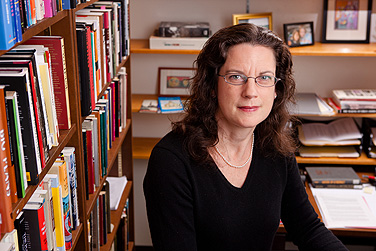Close Up
Wolcott examines 20th-century color line

Historian Victoria Wolcott teaches courses on the history of civil rights, African-American history and urban history. Photo: DOUGLAS LEVERE
-
 Print
Print -
 Comments
Comments
-
“The black-and-white dichotomy shapes so much of the (20th century’s) political, cultural and social life.”
The phrase “color line” was used as a reference to the racial segregation that existed in the U.S. after the abolition of slavery. First mentioned in an 1881 article by Frederick Douglass, the phrase gained fame when W.E.B. DuBois cemented it in his landmark 1903 treatise, “The Souls of Black Folk.”
“DuBois said that the story of the 20th century will be the color line and he was absolutely right,” observes Victoria Wolcott, associate professor in the Department of History. “The black-and-white dichotomy shapes so much of the (century’s) political, cultural and social life.”
Influenced by her mother, who she describes as an early feminist with an interest in social justice issues, Wolcott began to explore the effects of that color line as a graduate student at the University of Michigan. In the process, she has become a noted 20th-century historian.
She arrived at UB last fall after five years of teaching at St. Bonaventure University in Olean and nine years at the University of Rochester. She teaches UB graduates and undergraduates the history of civil rights, African-American history and urban history, along with several permutations of those areas, she says, such as the “Race in American Cities” seminar she conducted in her first semester that combined her interests in race, labor and urban history.
Those interests led her to develop her first book from her graduate dissertation, “Remaking Respectability: African American Women in Interwar Detroit,” which was published in 2001.
The book looks at African-American women in Detroit and how their work, culture and politics helped shape the life of the city. “I found that African-American women really were excluded from not only white-collar employment, but from blue-collar as well. The one niche area where they were able to find employment was domestic service,” she relates. “So they created opportunities for themselves by opening businesses, by engaging in what we call the informal economy, which can be anything from running numbers to more illicit kinds of activities. They had a kind of creative response to these restrictions that were placed upon them because of racial discrimination in the job market.”
The study made a significant impact. The book is being used in graduate courses in particular, but also to some extent in undergraduate courses in women’s history and African-American history. “I think I was at the beginning of what has really developed as a new sub-field in African-American women’s history when the book was published in 2001,” says Wolcott. “It was part of this new, growing field of research for people who were interested in the Great Migration of African Americans, urban history and women’s history.”
After a decade of research, her second book, “Race, Riots and Roller Coasters: The Struggle Over Segregated Recreation in America,” will be published in August by University of Pennsylvania Press. To some extent, this derived from her work on the first book.
“I was struck by the extent to which all sorts of public accommodations—particularly recreational spaces—were segregated. We associate that kind of Jim Crow segregation with southern cities and communities, and yet it’s very, very pervasive in the north,” she explains. “I was interested in thinking to what extent is segregation and the struggle against segregation a national story, not a southern story.”
The jumping-off point for the book was an article that she had written on the 1956 race riot that occurred on the Canadiana, the passenger ferry that ran between Buffalo and the Crystal Beach amusement park in Southern Ontario. On the park’s opening day that year, a large number of African-American teenagers went over and various scuffles broke out on the ferry and spilled into the park.
Essentially, she notes, what was happening in Buffalo in the 1950s was emblematic. “There was an influx of African Americans coming into Buffalo and also growing suburbanization and outmigration of certain groups of whites. African Americans were using recreational facilities in much larger numbers. This is often very disconcerting to whites, who perceive these spaces as being ‘safe and clean,’ in part because of the racial homogeneity of them. So there was a resentment.”
Wolcott’s research uncovered huge numbers of those kinds of riots, as well as cases of segregated exclusion.
“There were plenty of amusement parks in northern areas that were either segregated or African Americans could only go one day a week or one day a year, or in some cases, they could enter the amusement park but the swimming pools would be segregated, along with the ballrooms and the roller skating rinks,” she says. “The book is an attempt to tell this national story—and I do talk about the south as well—to demonstrate the extent to which segregation was a national phenomenon and the long-reaching effects of this.”
Wolcott is taken with her experience at UB going into her second semester. She will be teaching a new course on American utopian communities, a study she is considering for her next book.
“This university is quite strong in urban studies across a number of different disciplines. I really value those interdisciplinary connections,” she says. “The history department is an extremely collegial department—very productive and a very exciting department to be part of.”
Enhancing that collegiality is the presence of her husband, Erik Seeman, professor of history and director of the UB Humanities Institute. The couple lives in the village of Williamsville with their daughters, Nora, 14, and Maya, 12.
Wolcott is looking forward to becoming involved in community activities. “I like the idea that folks from the university and elsewhere are engaged in some really fascinating revitalization efforts in Buffalo,” she points out. “It’s definitely a good place to be an academic.”

Reader Comments